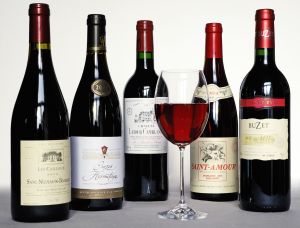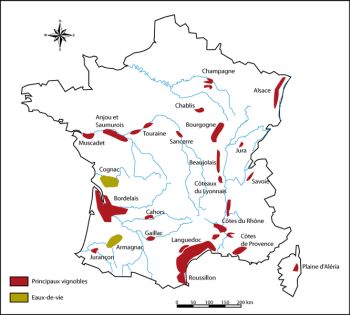 France is the birthplace of modern winemaking and serves as a model for wine production internationally. Even though it’s only about the size of Texas, France produces between 7 and 8 billion bottles per year and has the second-largest total vineyard area in the world. France has also been making, perfecting, and exporting their wines since the 6th century BCE, and the country has been associated with winemaking since before Roman times.
France is the birthplace of modern winemaking and serves as a model for wine production internationally. Even though it’s only about the size of Texas, France produces between 7 and 8 billion bottles per year and has the second-largest total vineyard area in the world. France has also been making, perfecting, and exporting their wines since the 6th century BCE, and the country has been associated with winemaking since before Roman times.
The tradition and history surrounding French wines are not the only things that make them so treasured. The fact of the matter is that French vineyards produce some of the highest quality wines in the world. France is also the source of many grape varieties (like Cabernet Sauvignon, Chardonnay, Pinot Noir, Sauvignon Blanc, etc.) that are now planted around the world, and French wine-making practices are copied in many other countries.
So, for those of us who are not sommeliers or wine experts, let’s brush up on some basic knowledge of French wines and the regions they come from.
French wine is divided into categories a couple of different ways:
>>Still feeling confused? Read my post on the French wine classification system.
 Alsace: This area in France borders Germany and is primarily known for its white and rosé wines. Sparkling sweet wines are also produced in this region, as the chilly temperatures are often best for making bubbly.
Alsace: This area in France borders Germany and is primarily known for its white and rosé wines. Sparkling sweet wines are also produced in this region, as the chilly temperatures are often best for making bubbly.
Bordeaux: This large region along the southern Atlantic coast of France has a long history of exporting wines and is known mostly for its rich, complex reds. In fact, Bordeaux wines are usually a blend of Cabernet Sauvignon and Merlot. However, while Bordeaux tends to be synonymous with reds, the region is also well known for its famous sweet white wine from Sauternes, usually paired with foie gras.
Burgundy: This area in eastern France is known for its bold Pinot Noir and Chardonnay. Burgundy actually has the largest number of appellations of any other region in the country, and is frequently divided into smaller subdivisions. The top wines from the region are found in the Cote d’Or (Gold Coast) – and because these wines command the highest prices, the name seems all too fitting.
Beaujolais: The southern regions of Burgundy near the Rhône valley, makes lighter, fruitier red wines, and is known for the famous Beaujolais Nouveau, a young red wine released each November and consumed by the New Year.
Chablis: A region sometimes lumped in with Burgundy, this area located between the Cote d’Or and Paris produces crisp white wines.
Champagne: This area close to Belgium and Luxembourg was the birthplace of sparkling wine; in recent decades France has protected its signature bubbly by disallowing sparkling wine producers to use the term “champagne” for wines not produced in this area of France. The region has the perfect chilly winter climate to produce Champagne and the most famous brands of bubbly, like Dom Perignon and Veuve Clicquot, have vineyards here.
Languedoc-Roussillon: This is the largest wine region by area in France, and it is where the majority of France’s cheap bulk wines are produced (which are still quite good!). This region is sometimes nicknamed the “wine lake,” and the vintners here are known for being more open to adapting new techniques in winemaking. You’ll often see wines from this region labeled “Vin de Pays d’Oc.”
Loire: This region stretches along the Loire Valley in central and western France and produces France’s highest quality white wines. The upper Loire is known for its Sauvignon Blanc, but the region is also known for its dry, sweet and sparkling wines from Tourraine and Chenin Blanc, as well as its mild reds from Saumur.
>>Read my post on vineyards in the Loire.
Provence: Southeastern France near the Mediterranean coast is one of the warmest regions of France, and as a result produces mostly white and rosé wines. Bordering the southern Rhône region, Provence has very similar wines, and is also home to some prestigious wine estates.
Rhône: The Rhône Valley in Southeastern France along the Rhône River is known for mostly for its red wines and competes with Bordeaux as a major producer and exporter of French red wines.
Savoie: This region in the French Alps bordering Switzerland is mostly known for its cheeses, great skiing and mountain vistas, but the region also produces some excellent white wines. Because of the chillier mountain temperatures, Savoie grows grapes that are unique to the region and produce distinct wines.
Southwest France: The Sud-Oeust of France is known for its Medieval fortresses like Carcassonne and the Citadelles du Vertige as well as for its rich foods like foie gras and duck confit, and red wines similar to those from Bordeaux and sweet, white wines similar to Sauternes. Many of the wines from this region do not have AOC ratings but are VDQS classified, which basically means they are wines in the “waiting room” for the prestigious AOC classification. These are some of the highest quality wines in France without as big of a price tag. (If you want to know more about these classifications, check out my post on understanding French wine classifications).
>>Want to know what to pair these wines with? French Food of course!